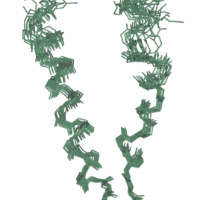15-May-2018
Each year Instruct support small pilot research and development projects in any area of structural biology up to a maximum of €15,000 per project. We look for projects on basic or applied research which are preliminary in nature with an expectation of collecting data that may be included in support of an application for more substantial funding through conventional routes. Projects that include technology and/or software development are encouraged. We are delighted to share some of the results from one of the successful applications from the 2016 call in advance of their publication.
Article by Anna Maria D’Ursi, Manuela Grimaldi, Ilaria Stillitano and Mario Scrima
University of Salerno, Italy
Membrane proximal extracellular region (MPER) is a polypeptide domain belonging to the envelope glycoproteinsGp41, of human immune deficiency virus (HIV), and Gp36, of feline immune deficiency virus (FIV). During the virus entry, MPER and several characteristic functional domains of Gp41 or Gp36, interact each other forming a low energy stable complex capable of destabilizing host cell membrane, determining virus and cell membrane fusion.Intense research activity on Gp41 structural domains led to the development of Fuzeon®, a virus entry inhibitor, approved for anti-HIV therapy. In view of the identification of new anti-HIV entry inhibitors, we recently produced and solved the NMR structure of Gp36-MPER (PDB ID: 6FTK). (Bio-NMR Research Infrastructure)Thanks to INSTRUCT R&D Award, we received part of the resources to design, synthesize and test new peptide and non-peptide molecules as possible binders of Gp36-MPER. Our analysis, based on chemical shift mapping techniqueon 15N labelled Gp36-MPER, evidenced the propensity of C8 peptide, an antiviral peptide previously identified in our laboratory, to bind Gp36-MPER. Interaction of Gp36-MPER with C8 resulted in a final synergic destabilizing effect on lipid membrane surfaces.Starting from C8 structural motifs,new peptide and non-peptide C8 derivatives are under scrutiny as possible, improved binders of Gp36-MPER.
Figures: NMR structure bundle of gp-36MPER in DPC/SDS 90:10(left); the residues affected by lipid membrane contact are highlighted (right)
